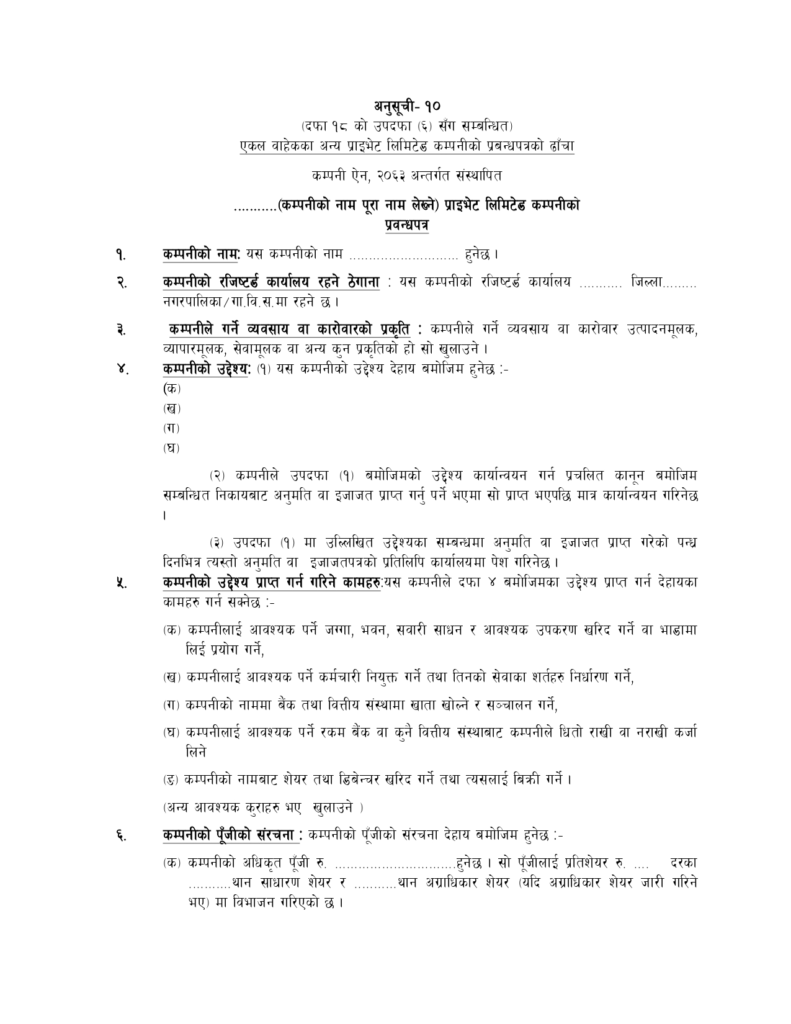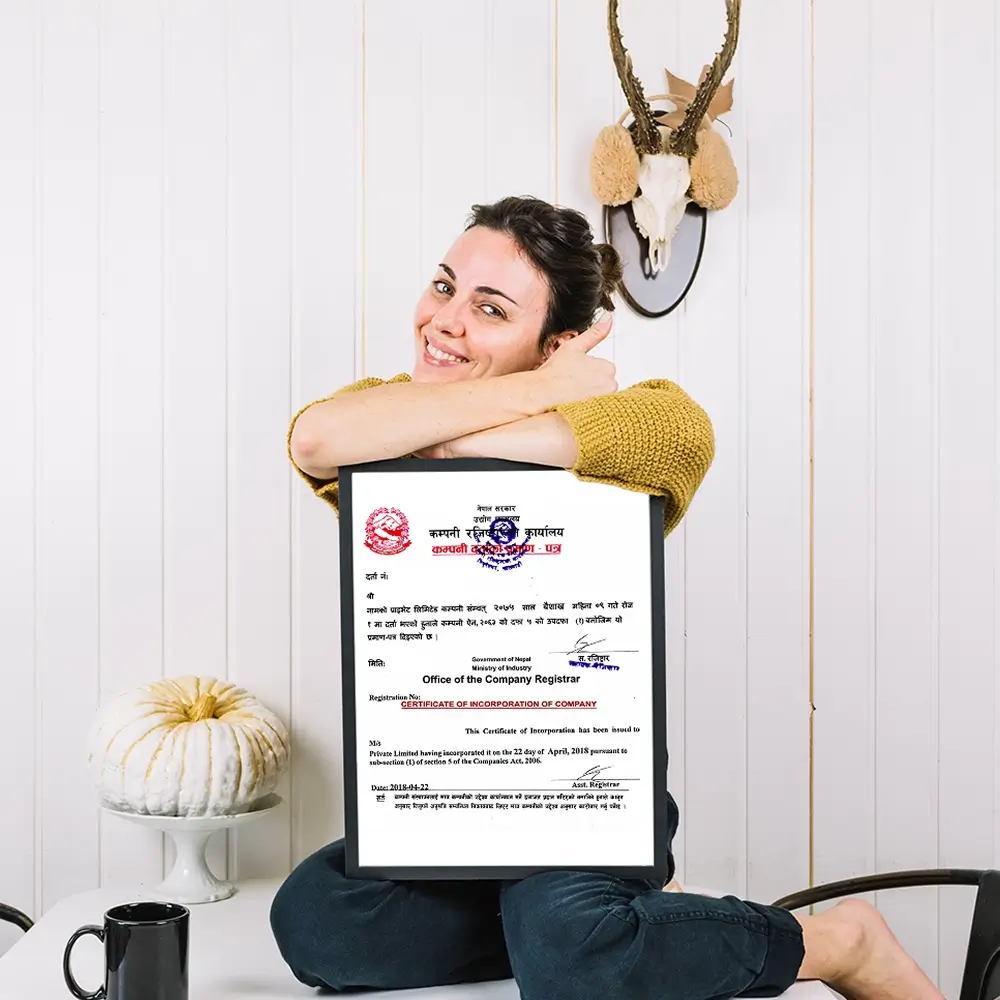Starting a business is exciting, but it comes with a lot of paperwork and legal processes.
One of the most important documents you need to prepare is the Memorandum of Association (MoA).
If you plan to register a company in Nepal, you must know what an MoA is, why it matters, and how to prepare it.
It is not just a legal formality. It is the foundation of your company’s identity and operations.
At Company Sewa, we’ve helped entrepreneurs and business owners register companies in Nepal for over 10 years. We guide you through every step, including drafting and preparing the MoA and Articles of Association (AoA).
Our goal is to make sure your company is registered properly and legally.
👉 You can also watch our detailed video: What is a Memorandum of Association (MoA) and AoA for a clear, visual understanding.

What is a Memorandum of Association (MoA)?
The Memorandum of Association (MoA) is a legal document that explains the basic details and goals of a company.
In Nepali, it is called प्रबन्धपत्र (Prabandhapatra).
It explains who you are, what your company does, and where it operates.
Think of the MoA as the birth certificate of your company. It officially declares your company’s name, type, goals, and structure. Without it, you cannot register a company in Nepal.
Simple Definition:
The Memorandum of Association (MoA) is a legal document prepared during company registration. It outlines the company’s name, objectives, registered office, capital structure, and the liability of shareholders.
In Nepal, the MoA is required under the Companies Act, 2063 (2006). It must be submitted to the Office of the Company Registrar (OCR) when you apply for registration.
Purpose of the Memorandum of Association
The MoA clearly defines what your company can and cannot do. It tells shareholders, investors, and the government the boundaries of your business.
Key Purposes of an MoA:
- Establish the company’s identity (name, address, objectives).
- Inform stakeholders about the company’s nature and operations.
- Limit the powers of the company so it works within its objectives.
- Define the relationship between the company and its shareholders.
- Serve as a public document for anyone interested in your company.
In short, the MoA is the foundation of your business — legally, operationally, and strategically.
Importance of MoA in Company Registration
When you register a company in Nepal, the MoA plays a major role.
It’s one of the main documents required by the Office of the Company Registrar (OCR) and has both legal and practical importance.
Legal Importance:
- Required under Section 5 of the Companies Act of Nepal.
- Serves as legal proof of your company’s existence.
- The OCR will not approve registration without a valid MoA.
- Defines the legal boundary of your business. Your company cannot do activities outside what’s mentioned in the MoA.
Practical Importance:
- Helps investors, partners, and clients understand your company’s purpose.
- Acts as a reference for business and legal decisions.
- Ensures transparency about ownership, objectives, and structure.
- Builds trust by showing that your business is legitimate and well-organized.
Main Clauses of the Memorandum of Association
The MoA includes several key sections, called clauses. Each one serves a special purpose.
1. Name Clause
This clause mentions the official name of your company.
Example: “ABC Trading Private Limited.”
Rules:
- The name must be unique and not the same as any other company in Nepal.
- Private companies must end with “Private Limited,” and public companies with “Limited.”
- The name should not be misleading, offensive, or against public interest.
2. Address (Registered Office) Clause
This clause states where your company’s registered office is located.
It’s the place where all official letters and notices will be sent.
Example: Registered Office: Kathmandu Metropolitan City, Ward No. 10, Bagmati Province, Nepal.
If you change your office later, you must update it with the OCR.
3. Object Clause
This is one of the most important parts of the MoA.
It defines the main objectives and activities your company will do.
Example:
- To trade, import, and export consumer goods.
- To provide consultancy and management services.
- To invest in real estate and construction projects.
Your company can only work within these objectives. That’s why you should define them carefully.
4. Liability Clause
This clause shows the extent of liability of the shareholders.
For a private limited company, liability is limited to the unpaid amount on the shares they own.
For example, if you have 100 shares worth Rs. 100 each and have paid Rs. 9,000 out of Rs. 10,000, your liability is Rs. 1,000.
5. Capital Clause
This clause declares your company’s authorized share capital and how it’s divided.
Example: Authorized Capital: Rs. 10,00,000 divided into 10,000 shares of Rs. 100 each.
It also mentions how many shares each shareholder owns.
6. Association or Subscription Clause
This clause confirms that the founders (promoters) agree to form the company and take shares.
Each promoter must sign the MoA and include:
- Full name, address, and citizenship number.
- Number of shares they agree to buy.
- Signature and date.
Difference Between MoA and AoA (Articles of Association)
The MoA defines what a company is and what it does. The AoA defines how the company operates internally.
| Basis | Memorandum of Association (MoA) | Articles of Association (AoA) |
|---|---|---|
| Meaning | Defines the basic details and goals of the company. | Defines internal rules for management. |
| Purpose | Sets the boundary for company operations. | Guides day-to-day internal management. |
| Scope | External — deals with outsiders. | Internal — deals with directors and shareholders. |
| Required for Registration? | Yes | Yes |
| Change Process | Harder — needs OCR approval. | Easier — can be changed by shareholders. |
| Examples | Name, objectives, capital, liability. | Meetings, voting rights, directors’ powers, dividends. |
Both MoA and AoA are essential for registering a company in Nepal.
Sample MoA Format in Nepali Language
The Office of the Company Registrar (OCR) provides sample formats of the MoA to make things easier.
These templates are in Nepali and follow the standard format required by the Companies Act of Nepal.
You can use them as a reference when drafting your own MoA.
| Download PDF | Sample Templates |
|---|---|
| MoA for Private Company | Download PDF |
| MoA for Public Company | Download PDF |

💡 Tip: The sample templates are very useful.
However, since every business is different, it’s better to get expert help from Company Sewa to customize your MoA before submission.
The sample MoA includes all key parts — such as the name clause, object clause, capital clause, and subscription details — written in official language suitable for submission to the OCR.
If you’re not confident writing in Nepali, Company Sewa can help you draft and review your MoA to meet all legal standards.
Common Mistakes When Preparing an MoA
Many entrepreneurs make small but costly mistakes when drafting their MoA.
Here are the most common ones — and how to avoid them:
| ❌ Mistake | ✅ How to Avoid |
|---|---|
| Using a duplicate or restricted name | Always check the OCR name database first. |
| Unclear or narrow objectives | Write clear but flexible objectives. |
| Missing promoter signatures or details | Make sure all promoters sign properly. |
| Incorrect capital structure | Clearly mention authorized, issued, and paid-up capital. |
| Ignoring legal compliance | Review everything according to the Companies Act. |
At Company Sewa, we help clients avoid these mistakes so their documents get approved quickly and smoothly.
How Company Sewa Can Help You
At Company Sewa, we specialize in company registration services in Nepal. This includes drafting, preparing, and filing the Memorandum of Association (MoA) and Articles of Association (AoA).
Our Services Include:
- Expert advice on choosing the right company type.
- Preparation of customized MoA and AoA based on your needs.
- Review and correction to meet OCR requirements.
- Complete registration support from start to finish.
- Guidance on post-registration compliance and updates.
With over 10 years of experience, we’ve helped thousands of entrepreneurs start their businesses confidently and legally.
Need Help? Get Expert Guidance
Avoid delays and rejections. Let Mr. Dipendra Shah (10+ years experience) guide you.
WhatsApp / Call: +977 9851 253 180
Frequently Asked Questions (FAQs)
Here are some common questions about the Memorandum of Association (MoA) in Nepal. We’ve kept the answers short and practical to make them easy to understand.
Is the MoA mandatory for company registration in Nepal?
Yes. The Memorandum of Association (MoA) is mandatory for registering any type of company in Nepal.
Without a properly drafted MoA, the Office of the Company Registrar (OCR) will not approve your company registration application.
Who prepares the MoA in Nepal?
The promoters (founders) of the company are responsible for preparing the MoA. However, since the document must meet legal requirements under the Companies Act, 2063, most business owners choose to get help from professionals like Company Sewa. We ensure that your MoA is correctly drafted, formatted, and compliant with all OCR rules.
In which language should the MoA be written?
The MoA must be written in Nepali language for submission to OCR. A translated version in English can be kept for reference.
Can I use an English version of MoA for registration?
No. The final submitted version must be in official Nepali as per the OCR requirement.
Can I change the MoA later?
Yes, but changes to MoA (such as objectives or share capital) require formal approval from the OCR through a company update process.
What are “primary” and “ancillary” objectives in MoA?
In your Object Clause, you must include:
- Primary objectives: The main activities or purposes your company was formed to do (e.g., trading goods, providing services, manufacturing, etc.).
- Ancillary objectives: Supportive or related activities that help achieve your main objectives (e.g., marketing, training, consulting, or managing assets).
Defining both clearly ensures your company can operate smoothly without exceeding legal limits.
Do I need a lawyer to draft the MoA?
It’s not mandatory, but highly recommended to consult legal experts or use a trusted service like Company Sewa to ensure compliance.
How many shareholders’ details must be included in the MoA?
For a Private Limited Company, at least one shareholder is required. For a Public Limited Company, a minimum of seven shareholders is required.
The MoA must include each shareholder’s:
- Full name
- Address
- Citizenship or registration number
- Number of shares taken
- Signature
Can I download a template of the MoA in Nepali?
Yes. The Office of the Company Registrar (OCR) provides official sample templates of the Memorandum of Association (MoA) in Nepali for both private and public companies.
These templates are great references, but it’s best to get them reviewed by experts like Company Sewa before submission.
How much time does it take to prepare and submit the MoA?
With the help of experts like Company Sewa, the MoA can be prepared within 1–2 working days, and submission can be done immediately.
Can Company Sewa help me draft and translate the MoA in Nepali?
Absolutely! Company Sewa provides complete assistance in drafting, translating, and reviewing your Memorandum of Association (MoA) and Articles of Association (AoA).
Our experts:
- Prepare customized MoA and AoA in both English and Nepali
- Ensure compliance with the Companies Act, 2063
- Help you submit all required documents to the Office of the Company Registrar (OCR)
We make sure your MoA is legally accurate, clearly written, and approved without hassle.

